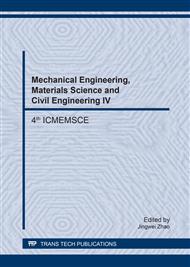[1]
EN 1998-1. Design of Structures for Earthquake Resistance: European standard. Brussels: Comite Europeen de Normalisation (CEN), 2004. ISBN: 0580458725.
Google Scholar
[2]
EN 15129. Antiseismic Devices: European standard. Brussels: Comite Europeen de Normalisation (CEN), 2009. ISBN: 9780580550843.
Google Scholar
[3]
K. Hjelstad, E. Popov, Seismic Behaviour of Active Beam Links in Eccentrically Braced Frames. Earthquake Engineering Research Center, 1986, 169 pp, UCB/EERC-86/01.
Google Scholar
[4]
P. Dusicka, M. Itani, G. Buckle, Cyclic Response of Plate Steels under Large Inelastic Strains, Journal of Constructional Steel Research 63(2) (2007) 156-164, DOI: 10. 1016/j. jcsr. 2006. 03. 006.
DOI: 10.1016/j.jcsr.2006.03.006
Google Scholar
[5]
J. Protivinsky, M. Krejsa, Material Study of a Short Seismic Link in a Dissipative Structure of a Vertical Industrial Boiler, Applied Mechanics and Materials 623 (2014) 10-17, DOI: 10. 4028/www. scientific. net/AMM. 623. 10.
DOI: 10.4028/www.scientific.net/amm.623.10
Google Scholar
[6]
J. Protivinsky, M. Krejsa, Making Use of the Principle of Energy Dissipation in the Seismic Design of a Steel Structure of a Steam Boiler, Transaction of the VSB – Technical University of Ostrava, Civil Engineering Series 12(2) (2012).
DOI: 10.2478/v10160-012-0028-0
Google Scholar
[7]
A. Zsarnoczay, V. Budahazy, L. Vigh, L. Dunai, Cyclic Hardening Criteria in EN 15129 for Steel Dissipative Braces, Journal of Constructional Steel Research 83 (2013) 1-9, DOI: 10. 1016/j. jcsr. 2012. 12. 013.
DOI: 10.1016/j.jcsr.2012.12.013
Google Scholar
[8]
J. Vican, P. Janik, Experimental and Numerical Analysis of Beam-Column Resistance, Procedia Engineering 91 (2014) 280-285, DOI: 10. 1016/j. proeng. 2014. 12. 060. ISSN 18777058.
DOI: 10.1016/j.proeng.2014.12.060
Google Scholar
[9]
P. Dusicka, R. Iwai, Development of Linked Column Frame System for Seismic Lateral Loads. Structural Engineering Research Frontiers. Reston, VA: American Society of Civil Engineers, 2007, (Vol. 1): 1-13. DOI: 10. 1061/40944(249)63. ISBN 978-0-7844-0944-2.
DOI: 10.1061/40944(249)63
Google Scholar
[10]
A. Strauss, Z. Kala, K. Bergmeister, S. Hoffmann, D. Novak, The object of this contribution is the comparison of the statistical characteristics of yield strength, ultimate strength and ductility of Austrian and Czech steels, Stahlbau 75(1) (2006).
Google Scholar
[11]
N. Jendzelovsky, L. Balaz, Analysis of cylindrical tanks under the seismic load, Key Engineering Materials 691 (2016) 285-296, DOI: 10. 4028/www. scientific. net/KEM. 691. 285.
DOI: 10.4028/www.scientific.net/kem.691.285
Google Scholar
[12]
P. Kotes, M. Farbak, P. Kotula, M. Brodnan, A. Cavojcova, Using CFRP lamellas for strengthening of dynamically loaded beams, Procedia Engineering 65 (2013) 302-310, DOI: 10. 1016/j. proeng. 2013. 09. 047.
DOI: 10.1016/j.proeng.2013.09.047
Google Scholar
[13]
K. Kotrasova, I. Grajciar, E. Kormanikova, Dynamic time-history response of cylindrical tank considering fluid - Structure interaction due to earthquake, Applied Mechanics and Materials 617 (2014).
DOI: 10.4028/www.scientific.net/amm.617.66
Google Scholar
[14]
J. Kralik, Risk-based safety analysis of the seismic resistance of the NPP structures, in: G. Lombaert, G. Muller, G. De Roeck, G. Degrande (Eds. ), Proceedings of the 8th International Conference on Structural Dynamics - EURODYN 2011, University of Southampton, Institute of Sound Vibration and Research, 2011, pp.292-299.
Google Scholar
[15]
I. Major, M. Major, Modeling of wave propagation in the ADINA software for simple elastic structures, Advanced Materials Research 1020 (2014) 171-176, DOI: 10. 4028/www. scientific. net/AMR. 1020. 171.
DOI: 10.4028/www.scientific.net/amr.1020.171
Google Scholar
[16]
V. Salajka, P. Hradil, J. Kala, Assess of the nuclear power plant structures residual life and earthquake resistance, Applied Mechanics and Materials 284-287 (2013) 1247-1250, DOI: 10. 4028/www. scientific. net/AMM. 284-287. 1247.
DOI: 10.4028/www.scientific.net/amm.284-287.1247
Google Scholar
[17]
J. Navratil, Structural analysis of bridges, legitimate conservatism and obsolete theories, Concrete Engineering International 8(1) (2004) 17-19.
Google Scholar


